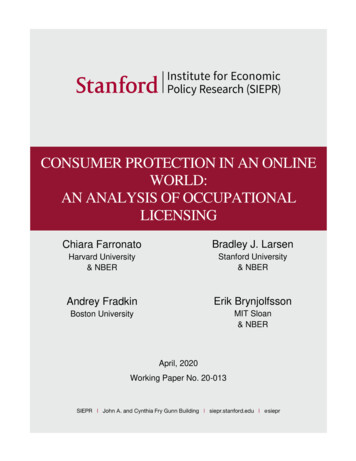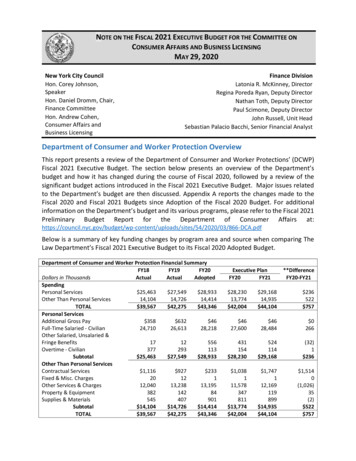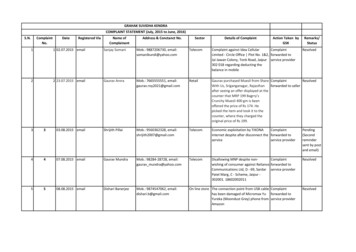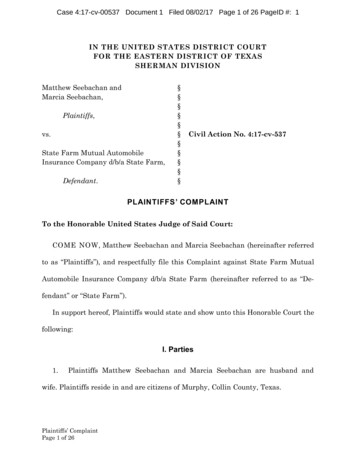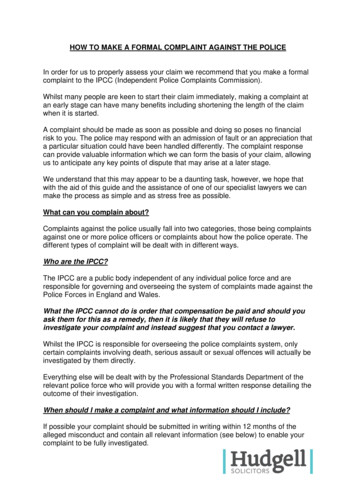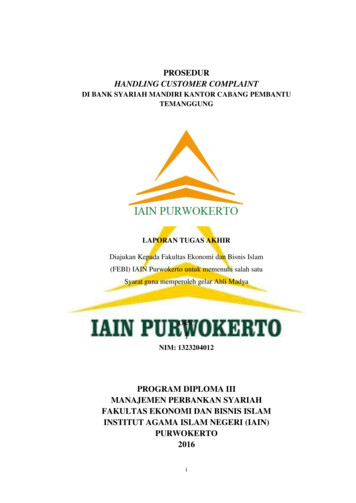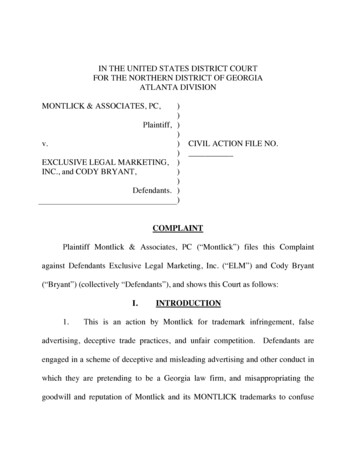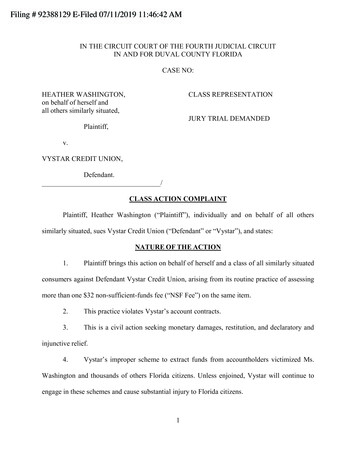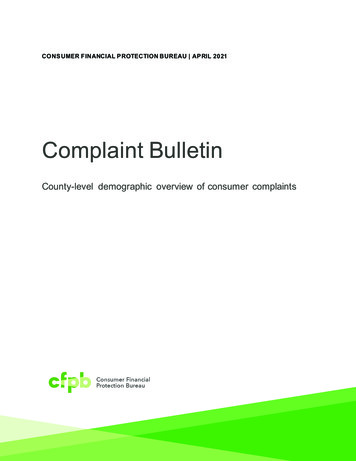
Transcription
CONS UMER FINANCIAL P ROTECTION BUREAU AP RIL 2021Complaint BulletinCounty-level demographic overview of consumer complaints
Table of contentsTable of contents .11.Introduction .22.Complaint data .42.1Complaint process . 42.2Considerations . 53.Complaint analysis .74.Future work.125.Consumer resources.131CONSUMER FINANCIAL PROTECTION BUREAU
1. IntroductionIn July 2011, the Consumer Financial Protection Bureau (CFPB) began accepting consumercomplaints. Since then consumers have submitted approximately 2.9 million complaints to theCFPB about a variety of consumer financial products and services, including more than 700,000complaints since the declaration of the coronavirus (COVID-19) national emergency on March13, 2020. 1Consumer complaints are integral to the CFPB’s work. By collecting, investigating, andresponding to consumer complaints, the CFPB hears directly from consumers and can betterunderstand the types of challenges they are experiencing in the marketplace. 2 The CFPB also hasinsight into how companies are responding to their customers’ concerns. This informationsupports the CFPB’s work to supervise companies, enforce federal consumer financial laws,propose rules, identify and assess emerging issues, and develop tools that help empowerconsumers to make informed financial decisions.In this Complaint Bulletin, the CFPB analyzes complaints submitted by consumers by county. 3Using race and ethnicity estimates from the U.S. Census 2019 American Community Survey,each of the more than 3,000 counties in the United States have been grouped based on thewhite, non-Hispanic percentage of the population. 4 Counties where the non-white or Hispanicpopulations make up 61% or more of the total population are referred to as “predominantlyminority counties”; whereas, counties where the non-white or Hispanic populations make up1See Dodd-Frank Wall Street Reform and Consumer Protection Act of 2010, Pub. L. No. 111-203 (Dodd-Frank Act),Section 1002(4) (“The term ‘consumer’ means an individual or an agent, trustee, or representative acting on behalfof an individual.”).2Id. § 1021(c)(2).3This report is based on dynamic data and may differ from other public reports.4See U.S. Census 2019 American Community Survey (“2019 American Community Survey”), available athttps://www.census.gov/programs-surveys/acs (The American Community Survey provides a wide range ofimportant statistics (e.g., race, ethnicity, education, language, employment, etc.) for every community in thenation.).2CONSUMER FINANCIAL PROTECTION BUREAU
40% or less of the total population are referred to as “predominantly white, non-Hispaniccounties” for the purposes of this Complaint Bulletin. 5Key findings of this bulletin include: In 2020, the CFPB received more complaints per capita from consumers living inpredominantly minority counties. In 2020, consumers living in predominately minority counties submitted morecomplaints on a per capita basis in nearly every product category about which the CFPBaccepts complaints. From 2019 to 2020, complaints increased at a greater rate in predominantly minoritycounties compared to predominantly white, non-Hispanic counties.This Complaint Bulletin is organized as follows. Section 2 provides an overview of the complaintdata used in this report, as well as important considerations for this analysis. Section 3summarizes complaints submitted by consumers at the county level. Section 4 describes theCFPB’s ongoing work to better understand the communities who are submitting complaints tothe CFPB and how the problems they experience vary. Finally, Section 5 highlights consumerresources the CFPB published during the pandemic.53The 2019 American Community Survey reports on the percentage of the population identifying as Hispanic, Blackor African American, Asian Native Hawaiian and Other Pacific Islander, Some other race and Two or more races.CONSUMER FINANCIAL PROTECTION BUREAU
2. Complaint dataThis Complaint Bulletin relies primarily on data provided during the consumer complaintprocess (Section 2.1). Information collected during that process provides a rich dataset to studyconsumer problems in the marketplace; however, these data should be considered in the contextin which they are collected and analyzed (Section 2.2).2.1Complaint processCongress directed the CFPB to facilitate the centralized collection of, monitoring of, andresponse to consumer complaints regarding consumer financial products or services. 6 TheCFPB’s Office of Consumer Response (Consumer Response) performs this statutorily-mandatedfunction, analyzing and sharing complaint data to inform the marketplace and to empowerconsumers to take more control over their financial lives.The CFPB receives consumer complaints through its website, by referral from the White House,congressional offices, and other federal and state agencies, and by telephone, mail, email, andfax. 7 When consumers submit complaints online or over the phone, the CFPB asks them toidentify the consumer financial product or service with which they have a problem, as well as thetype of problem they are having with that product or service. 8The CFPB routes consumers’ complaints about financial products and services—and anydocuments they provide—directly to financial companies, and works to get consumers a timelyresponse, generally within 15 days. The CFPB expects companies to provide complete, accurate,and timely responses tailored to the issues described in each consumer’s complaint. When acompany cannot take action on a complaint—because it was submitted by unauthorized thirdparties; was the result of fraud, scams or business identity theft; or the company cannot confirm6See Dodd-Frank Act § 1013(b)(3).7Id.8 In 2020,consumers submitted complaints about a variety of consumer financial products and services: credit orconsumer reporting; debt collection; mortgages; credit cards; check ing or savings accounts; student loans; moneytransfers, money services, and virtual currencies; vehicle loans or leases; personal loans; payday loans; prepaidcards; credit repair; and, title loans.4CONSUMER FINANCIAL PROTECTION BUREAU
a commercial relationship with the consumer—the company can provide an administrativeresponse that includes a statement or other evidence supporting this response.As part of its commitment to transparency, the CFPB publishes consumer financial product andservice complaints that the CFPB sent to companies for response in the Consumer ComplaintDatabase. Complaints are published after the company responds, confirming a commercialrelationship with the consumer, or after 15 days, whichever comes first. Complaints referred toother regulators, such as complaints about depository institutions with less than 10 billion inassets, are not published in the Consumer Complaint Database. Narratives from complaints arepublished if the consumer opts to share their narrative publicly and after the CFPB takes stepsto remove personal information.For information about complaints and how the complaint process works, visitconsumerfinance.gov or read the 2020 Consumer Response Annual Report.2.2ConsiderationsThis Complaint Bulletin provides a high-level overview of the communities from which theCFPB received complaints in 2020, based on county-level demographic information. 9 There arecertain limitations to this analysis, including: 9The CFPB does not collect race and ethnicity information during the complaint process.Consumers provide their mailing address and have the option to provide their age andservicemember status. 10 This information can be used, along with other publicinformation, to approximate which communities are submitting complaints to the CFPB,Researchers have used the public Consumer Complaint Database to better understand experiences across differentcommunities. See e.g., Raval, Devesh, Which Communities Complain to Policymakers? Evidence from ConsumerSentinel (Oct. 2020), Economic Inquiry, Vol. 58, Issue 4, pp. 1628-1642, available athttp://dx.doi.org/10.1111/ecin.12838; Begley, Taylor A. and Purnanandam, Amiyatosh, Color and Credit: Race,Regulation, and the Quality of Financial Services (Aug. 2020), available athttp://dx.doi.org/10.2139/ssrn.2939923. Some researchers have also attempted to uncover differences in companyresponses across different communities. See e.g., Haendler, Charlotte and Heimer, Rawley, The FinancialRestitution Gap in Consumer Finance: Insights from Complaints Filed with the CFPB (Jan. 2021), available athttp://dx.doi.org/10.2139/ssrn.3766485. This complaint bulletin will not look at outcomes, such as relief providedto consumers; instead, it will focus on complaint submission rates, changes to those rates over time, and the types ofproducts consumers about which consumers complain. Future work will analyze complaint information at a moregranular level than what is published in the public Consumer Complaint Database (Section 4).10“Older consumers” and “servicemembers” are both self-identified. Servicemembers refers to servicemembers,veterans, and military families. “Older consumers” refers to consumers who voluntarily reported their age as 62 orolder.5CONSUMER FINANCIAL PROTECTION BUREAU
and to identify variations or patterns in problems and issues that different communitiesexperience in the consumer financial marketplace.116 For this analysis, the CFPB relies on county-level race and ethnicity information.Ongoing and future work will explore ZIP code- and census tract-level information toanalyze complaint demographics at a more granular level. The results of this ComplaintBulletin are consistent with other studies examining communities that submitcomplaints to policymakers. 11 In Section 3, complaint counts are sometimes expressed on a per capita basis, based onthe population of the county, not the number of consumers of the product in the county.True per capita value would consider only the number of participants in a given market.(For example, credit card complaints would be expressed as a count per credit cardholders.)See e.g., Raval, Devesh, supra note 9 (study examined data from the Consumer Sentinel Network and found highercomplaint rates in more heavily Black , more educated, higher income, older, and more urban communities, andhigher rates of complaints from Black and college educated communities for complaints submitted to the CFPBcompared to the Federal Trade Commission or the Better Business Bureaus).CONSUMER FINANCIAL PROTECTION BUREAU
3. Complaint analysisThis Complaint Bulletin relies on demographic estimates from the U.S. Census 2019 AmericanCommunity Survey to divide counties into one of five groups based on minority percentage. 12Minority percentage was calculated for each county by dividing the non-white or Hispanicpopulation by the total population. 13 Counties where the total percentage of these values was61% or more are considered predominantly minority counties. Counties where the totalpercentage was less than or equal to 40% are considered predominantly white, non-Hispaniccommunities.Each complaint was mapped to a county, using the mailing address provided by the consumer intheir complaint submission, which was then assigned to one of five groups: 1-20%, 21-40%, 4160%, 61-80%, and 81-100% minority. For example, a complaint submitted by a consumer whoreported a mailing address in Chicago, Illinois (Cook County) was assigned to the 41%-60%group. Complaints where the address could not be mapped were excluded from this analysis. 14COUNTI ES BY MI NORITY P ERCENTAGEFigure 1 shows the county breakdown based on information provided in the AmericanCommunity Survey. In this figure, orange denotes predominantly minority counties and bluedenotes predominantly white, non-Hispanic counties.12See 2019 American Community Survey, supra note 4.13Id.14Approximately 5% of complaints received during 2020 are excluded from this analysis.7CONSUMER FINANCIAL PROTECTION BUREAU
FIGURE 1:COUNTIES BY MINORITY PERCENTAGECounty minority %81% - 100%61% - 80% Mapbox OSMd Mapbox OSM 2021 Mapbox OpenStreetMap41% - 60%21% - 40%1% - 20%The largest group, based on total population, is comprised of counties where 21%-40% of thepopulation is estimated to be a member of a minority group (see Table 1).COMP LAINTS S UBMITTED BY CONSUMERS BY COUNTYThe CFPB received more complaints per capita from consumers living in predominantlyminority counties. The largest per capita volume (see Table 1) and rate of increase in complaintsfrom 2019 to 2020 (see Figure 2) were in 61%-80% minority counties. Predominately whitecounties with a minority population less than 21%, had the fewest complaints per capita and thesmallest rate of increase.8CONSUMER FINANCIAL PROTECTION BUREAU
TABLE 1:COUNTY GROUPSCounty groupsNumber ofComplaints per(% minority)counties2020 complaintsTotal Population100k population81% - 100%5425,5029,715,906262.561% - 80%178153,31855,617,136275.741% - 60%401163,86384,547,548193.821% - 40%748122,82697,566,911125.91% - 20%1,76148,59377,250,29462.9US Total3,142514,102324,697,795158.3Figure 2 plots the percentage increase in complaints by share of minority population (indexed toJanuary 2018 complaints).FIGURE 2:COMPLAINT VOLUME PERCENTAGE INCREASE BY MINORITY SHARE, INDEXED TO 2018COMPLAINT AVERAGECounty minority percentage81% - 100%61% - 80%41% - 60%21% - 40%1% - an-20Jan-19Jan-20Jan-19Jan-20Jan-19Jan-20COMP LAINTS S UBMITTED P ER CAP ITA BY P RODUCT AND COUNTYFigure 3 shows the types of products consumers complained about across the five groups.Consumers living in predominantly minority counties submitted more complaints on a percapita basis in nearly every product category. The exceptions were complaints about prepaidcards, student loans, credit repair, and title loans.9CONSUMER FINANCIAL PROTECTION BUREAU
FIGURE 3:2020 COMPLAINT VOLUME PER 100K POPULATION BY PRODUCT AND COUNTY GROUPSCredit or consumer reporting189.5188.094.7115.368.326.3Above US avgBelow US avgUS avg24.2Debt collection30.337.630.120.312.310.4Credit .58.35.28.4Checking or savings9.17.74.73.4Money transfer or service, virtual currency4.04.34.13.22.12.7Vehicle loan or lease3.13.43.42.51.72.2Prepaid card1.72.72.52.02.02.21.81.7Student loan1.61.61.11.3Personal loan1.6Payday loan0.61.71.71.20.90.40.50.60.40.30.40.30.3Credit repair0.30.20.20.2Title loan0.10.20.20.10.1Credit or consumer reporting appears to cause significantly more issues for consumers inpredominantly minority counties than in predominately white, non-Hispanic counties. Indeed,credit or consumer reporting complaints are one of only two product categories where the percapita rate of complaints is higher for counties above 81% minority population than counties61%-80% minority. These consumers complained about credit or consumer reporting atapproximately twice the U.S. average. In its 2020 Consumer Response Annual Report, the CFPBnoted that a significant portion of credit or consumer reporting complaints are about attemptsto address identity theft-related issues. Complaints related to the accuracy and completeness of10CONSUMER FINANCIAL PROTECTION BUREAU
information on a consumer’s reports, as well as complaints about problems that a consumerencountered in a previous investigation, are also common. 15Debt collection also appears to cause more issues for consumers in predominantly minoritycounties than in predominately white communities. The most common debt collectioncomplaint is about attempts to collect a debt that the consumer reports is not owed. In thesecomplaints, consumers described a range of topics, such as being called about debts they do notrecognize, attempts to collect a debt that belongs to someone else, and being in collections forservices or products they did not receive. Additionally, similar to credit or consumer reportingcomplaints, consumers often report that a debt in collection was the result of identity theft.Complaints about debt resulting from identity theft have been increasing for several years. Inthese complaints, consumers often reported that they first learn of the existence of the debt afterreviewing their credit reports. Many of these consumers described completing an identity theftreport and contacting the collectors listed on their credit report in an attempt to remove thedebt.The CFPB is studying these issues, among others, as it seeks to understand the experiences ofdiverse communities in the consumer financial marketplace (see Section 4).15See Consumer Fin. Prot. Bureau, Consumer Response Annual Report (Mar. 2021), available pb 2020-consumer-response-annual-report 03-2021.pdf.11CONSUMER FINANCIAL PROTECTION BUREAU
4. Future workConsumer Response is tasked with operating the CFPB’s consumer complaint function and itsprimary focus is to ensure that the CFPB meets its statutory objective to collect, monitor, andrespond to consumer complaints. If current 2021 complaint volume trends continue, ConsumerResponse expects to handle more than 1 million complaints this year—more than twice thenumber of complaints handled in 2020, and more than in any previous year.Consumer Response plans to enhance the complaint form to create a new demographic sectionthat gives consumers the option to provide household size and household income information inaddition to age and servicemember information. The CFPB will also explore what additionaldemographic information may be appropriate to collect via the complaint process, such as raceand ethnicity. These enhancements will help the CFPB to better understand who submitscomplaints today and how that changes over time. Moreover, they may decrease reliance onproxies to understand the range of experiences across different products and across differentcommunities.Consumer Response is currently exploring how to best understand and highlight the experiencesof diverse communities who submit complaints to the CFPB. This work will look at the life cycleof consumer credit—from origination through collections and credit reporting—to understandconsumers’ diverse experiences in the marketplace. This work will use census tract-levelinformation to analyze complaint demographics at a more granular level.12CONSUMER FINANCIAL PROTECTION BUREAU
5. Consumer resourcesIn order to ensure consumers have timely and understandable information to make responsibledecisions about financial transactions, the CFPB released a variety of resources to helpconsumers manage their finances during the COVID-19 pandemic. This includes information onnew programs aimed at helping struggling consumers during this time. These programs include: Student loan payment suspension: Principal and interest payments on federally heldstudent loans are automatically suspended through September 30, 2021 Mortgage forbearance: Most homeowners can temporarily pause or reduce theirmortgage payments if they’re struggling financially. Help for renters: Federal, state, and local governments are offering help with housingexpenses and avoiding eviction. Stimulus payments
(For example , credit card complaints would be expressed as a count per credit card holders.) 11. See e.g., Raval, Devesh, supra. note 9 (study examined data from the Consumer Sentinel Network and fou nd higher complaint rates in more heavily Black, more educate


